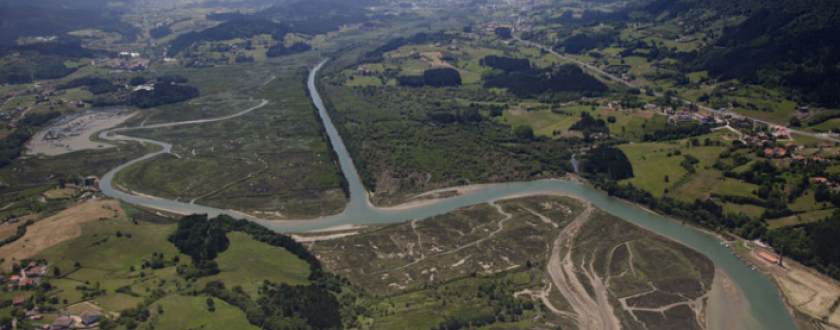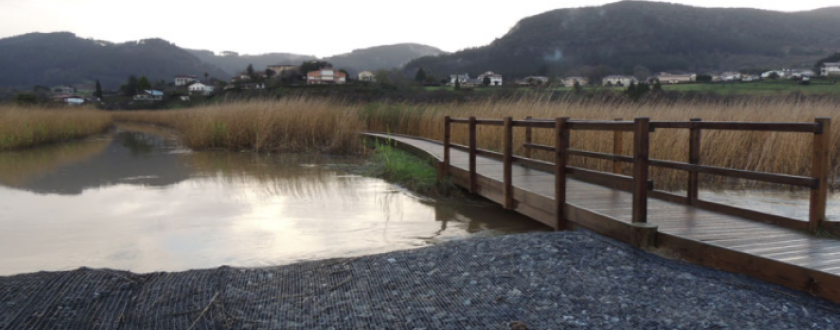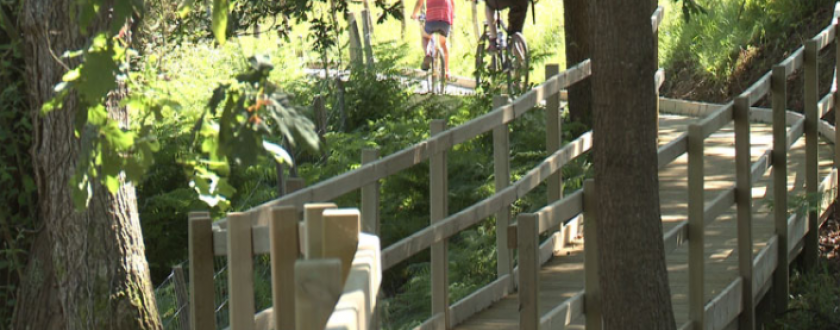Restoring the upper Oka river estuary, part of the Urdaibai Biosphere Reserve
Description of the case study
Climate change will increase pressure on the mouth of the Oka river, an area of high ecological value found within the Urdaibai Biosphere Reserve on the Basque Country’s Biscay coast. Increased temperatures and decreased annual rainfall, together with the increased frequency of extreme rain events will affect the water systems and river basin erosion, flows of suspended sediments in the estuary area, and the risk of obstructing the tidal river channels. Consequently, increased sea levels could lead to erosion in the intertidal and supra-littoral areas of the beach, as has already happened in certain areas, as well as increased erosion in the estuary’s marshes. For this reason, restoration work on the upper Oka river estuary intends to improve its ability to adapt and recover previously existing marshes.
According to the climate change projections included in the “2050 Basque Climate Change Strategy”, minimum temperatures will rise between 1 and 3 degrees by 2100, and precipitation will be reduced by between -10% and -30% by that same year. As a result, it is estimated that the sea level will increase by between 29 and 49cm by 2100, further increasing the flood risk in the reserve’s estuary. To this we can add the increased frequency and intensity of marine storms, which are responsible for eroding the intertidal and supra-littoral area of the beach.
Therefore, continued work to restore the Oka river estuary will be necessary over the next 50 years. This includes removing the artificial barriers that currently limit the estuary’s extension, and revitalising existing marshes.
The key targets of the actions implemented in the upper Oka river estuary are:
» Improving estuary ecosystem resilience against the impacts of climate change, including sea level increases and water system changes.
» Increasing local biodiversity thanks to the partial recovery of the ecosystem's functionality.
» Increasing sustainable public use of the Urdaibai Biosphere Reserve’s natural space.
» Revitalisation activities meant to recover the previously existing swampland, including the permanent flooding of the Barrutibase area of the upper estuary.
» Recovering the functionality of part of the original intertidal watercourse of the Oka river’s downriver section.
» Some of the dykes and other artificial barriers have been removed to improve the estuary’s restoration.
» Building embankments to create lagoons that will be transformed into intertidal areas in the future.
» Restoring the marshes to reduce the effects of increased sea levels and provide new habitats for diverse species of amphibians and birds, improving their ability to adapt.
» Building a 14km network of paths and a pedestrian and bike bridge to connect the neighbouring municipalities between themselves and to the Oka river estuary.
» Developing environmental education tools.
» Eradicating invasive species in a 700 hectare area.
Case study developed and implemented as a climate change adaptation measure.
The Basque Government Department of the Environment, Urban Planning, and Housing, and the Urdaibai Biosphere Reserve Service.
Additional Information
The upper Oka river estuary restoration project included the organisation of various meetings with different stakeholders, such as municipalities located in the area, property owners, and environmental associations. Stakeholder participation was sought in order to establish common goals. In addition, informative talks were held with the public at municipal councils, and recreational activities were developed to introduce the project and improve awareness on climate change adaptation.
The newly constructed network of paths has facilitated the connection between the various municipalities using sustainable transport (on foot and by bicycle).
Some of the municipalities included in the area where the restoration measures were implemented did not participate in the project, which posed a limitation to its full development. Therefore, some of the project’s phases (mainly those associated with removing some of the dams) must still be implemented.
In addition, the deep-rooted sense of ownership of those in the area that will be restored has made implementing some of the project’s activities difficult. The 1998 Coastal Law establishes an area 100m wide on both sides of the river, where landowners may object to the actions planned. For this reason, some of the actions included in this restoration project have not yet been implemented. Nevertheless, negotiations continue to ensure that the entire project is implemented.
The project has been financed entirely by the Basque Country Government’s Department of the Environment, Land Planning, and Housing. The total amount of the project’s budget is 2.5 million euros.
Law 42/2007 on natural heritage and biodiversity in Spain supports the execution of the upper Oka river estuary restoration project, since its aims include the conservation, sustainable use, improvement, and restoration of natural habitats and ecosystems. The Urdaibai biosphere reserve is located in the Basque Country, where the Municipal Council has laid out various strategies and plans to promote this type of restoration work, among which we can note the “2050 Basque Country Climate Change Strategy”, the 2020 Environment Framework Programme, and the Biodiversity Strategy.
01/01/2010 - 05/05/2021 (11 years - in progress)
Reference information
PYRENEAN CLIMATE CHANGE OBSERVATORY
Avenida Nuestra Señora de la Victoria, 8
22.700 - Jaca
Huesca - España
+34 974 36 31 00
info_opcc@ctp.org







